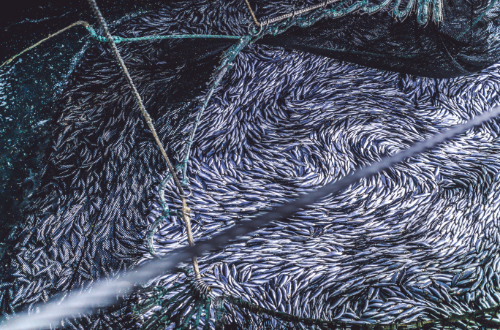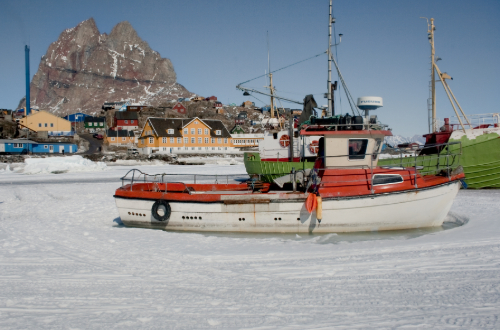Introduction
Investigating ecosystem tipping points and cascades in the Arctic Seas

Melting ice in the Arctic is a tipping element
The reduction of Arctic sea ice and melting of the Greenland Ice sheet are examples of tipping elements which have global effects within the earth system. Between 1994 and 2017, about 28 trillion tons of ice entered the seas globally, of which about 60% was from the Northern hemisphere. The Greenland ice sheet alone lost more than 530 billion tonnes in 2019. All of this additional freshwater input into the seas has several effects. First, it contributes to sea level rise, which is perhaps the most well-known effect. The additional input of freshwater also affects the chemistry and physics of the ocean, as freshwater has different a composition and density than sea water.
More freshwater = more layering in the ocean
As more freshwater enters into the seas within the Arctic, it creates a
layer of less-dense water on top of the more saline water, thus
strengthening the stratification (layering) of the Arctic seas. This
disrupts the vertical mixing of water, which is typical of polar seas. It
can potentially disrupt the upward mixing of nutrients that support a high
primary production and eventually productive fisheries, while also
preventing or slowing the sinking of cold, salty water that drives the
circulation patterns and deep-sea currents. It is for this reason that
scientists worry that the Atlantic Meridional Overturn Circulation (AMOC)
which Gulf Stream in the Atlantic Ocean is part of, may weaken, with knock
on implications for the global climate.
At the same time, the Arctic is changing in other, similarly profound ways.
Water temperatures are increasing at a rate that is twice the global
average, species from temperate regions are appearing and polar species are
moving northward, and the timing of annually recurring events is changing.
It is clear that biodiversity and the ecosystem functions in Arctic waters
are being assaulted and irrevocably altered. However, the impact that these
changes will have on two key ecosystem services, fisheries and carbon
sequestration, is still largely unknown.
Physical changes can trigger biological changes, creating a cascade

When a threshold is crossed in one part of the system, such as melting of
the Greenland Ice Sheet, it can result in changes in another partw of the
system, such as the open ocean ecosystem, which can reach its own tipping
point – an ecosystem regime shift where one type of marine community changes
to another type of community. This is called a tipping cascade with multiple
tipping points. A decrease in Arctic Sea Ice and melting of the Greenland
Ice sheet, and subsequent increase in freshwater inflow and stratification,
can trigger a change in the biological system: an “ecosystem tipping
cascade”.
Much of the annual primary production in a seasonally-pulsed pelagic system
typically takes place during the spring bloom, when abundant nutrients and
sufficient light support a high production of large phytoplankton. The
theory is that with warming and / or freshening of the surface waters, the
layering - or stratification - would strengthen. This could trigger a change
in the phytoplankton production and community composition – an ecosystem
tipping cascade with consequences that could cascade all way up to marine
mammals, fisheries production, human systems and global climate.
Where does ECOTIP come in?
ECOTIP operates at this important link between the physical and biological
systems, where a regional change in the hydrography of the Arctic Ocean
might trigger a biological change at the base of the marine food web with
cascading effects both on the regional and local socio-economic systems
through fisheries, and on the global climate through carbon sequestration.
ECOTIP is attempting to anticipate and predict these changes. Yet a few
knowledge barriers still exist:

©iStockphoto / Elif Bayraktar
We still don´t have a
good understanding how marine biodiversity in the Arctic is responding to
pressure from multiple sources. These include climate-related pressures such
as temperature, salinity and pH, as well as land and ocean-based stressors
in the form of invasive species, pollution such as heavy metals, marine
litter and oil, and fishing. How organisms will respond to combinations of
these stressors is largely unknown.
Our current way of
describing marine biodiversity and modelling it has its limitations. Despite
a century of detailed taxonomic studies, over 90% of the Arctic marine
species (macro-organisms) are currently thought to be undiscovered. This
makes it difficult to connect species, ecosystem functions and services, and
hampers efforts to model the system.
We are unable to
predict what are the consequences of the changes in plankton community
composition for either carbon sequestration or fisheries.
Our knowledge is
still fragmented of how biological changes are interacting with human
decisions and behaviour, including how fisheries resources are managed in
the Arctic. This limits our ability to develop adaptation options jointly
with local communities and Indigenous Peoples in the Arctic.
How will ECOTIP address these issues, and how is it unique?

©fruchtzwerg's world
We will apply new
molecular methods on environmental DNA (“eDNA”) to detect invasive species
in the Arctic. eDNA refers to DNA molecules that can be collected from the
environment (e.g. water samples). The usage of eDNA for species monitoring
is revolutionary as it saves time, costs, and workload without impairing
neither the target organism nor the ecosystem.
We will also apply the
latest developments in paleo-oceanography by examining sediment cores, to
peer into the past one thousand years, giving new insights into on the
effects of multiple stressors and the speed of the recovery in marine
biodiversity.
We will apply the
traits-based approach: we will approach changes in Arctic biodiversity and
associated ecosystem consequences through a trait-based approach, where
species will be replaced by their functional traits. This helps us to
overcome the challenge that a large amount of unknown species still exist. A
trait-based approach also allows for realistic scenarios of biodiversity
change as a response to multiple anthropogenic stressors, since the
likelihood of regime shifts, changes in food web interactions or the
stability of the ecosystem can be studied as a function of trait
composition.

We will fill crucial gaps
in understanding the biological pump: we will provide mechanistic
understanding of the unknown processes that are ignored in current model
representations of the biological pump, such as autotrophic production by
archaea in the twilight zone, export flux due to sinking of small
phytoplankton and cyanobacteria, and degradation of export flux by
particle-colonising zooplankton – all of which have the potential to
radically change the Earth System Model predictions that IPCC and other
assessments rely on.
We will co-create
knowledge with local communities in the Arctic: We will work closely with
fisheries communities and other groups in Greenland and elsewhere, drawing
on in-depth traditional knowledge of local societies and stakeholders, and
bring in research and insights into invasive species and their monitoring,
ecosystem service changes, predictions of ecosystem tipping cascades, and
socio-economic modelling and forecasting. This two-way process will both
increase our knowledge on the future Arctic ecosystem, and help to co-create
adaptation scenarios.
We will develop Bayesian
networks, which are networks of connected variables that can generate
predictions based on assumptions. Bayesian networks can be used to predict
the ecosystem vulnerability through different stressor combinations. It can
also be used as a knowledge-driven tool to interact with our stakeholders
and target groups, for example by exploring various ecosystem scenarios.
